HBS108 Assignment Task 1: Evaluating Evidence for Healthcare
VerifiedAdded on 2023/06/14
|8
|1323
|392
Homework Assignment
AI Summary
This assignment focuses on sourcing, identifying, and evaluating evidence within the context of healthcare research. It includes deconstructing a research article citation, describing inductive and deductive research approaches, and explaining the characteristics of qualitative research. The assignment further involves formulating a research hypothesis and question, identifying relevant databases and search terms, and providing a Deakin-Harvard citation. Additionally, it requires defining systematic reviews and explaining their importance to health professionals. The solution also includes abstracts from provided research papers on C-reactive protein's relation to diabetes and the link between breastfeeding and intelligence, offering a comprehensive overview of evidence-based practice in healthcare. Desklib provides solved assignments for students.
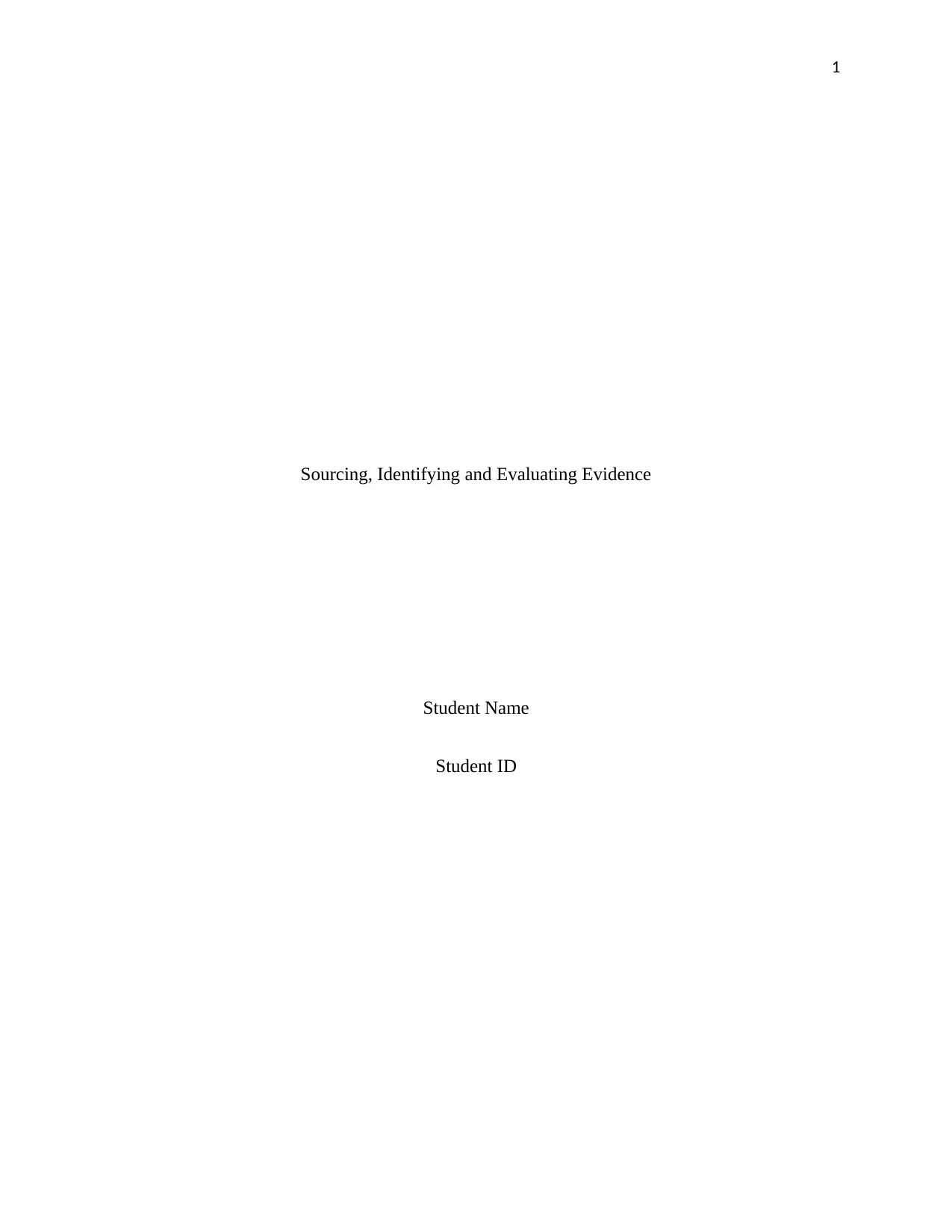
1
Sourcing, Identifying and Evaluating Evidence
Student Name
Student ID
Sourcing, Identifying and Evaluating Evidence
Student Name
Student ID
Paraphrase This Document
Need a fresh take? Get an instant paraphrase of this document with our AI Paraphraser
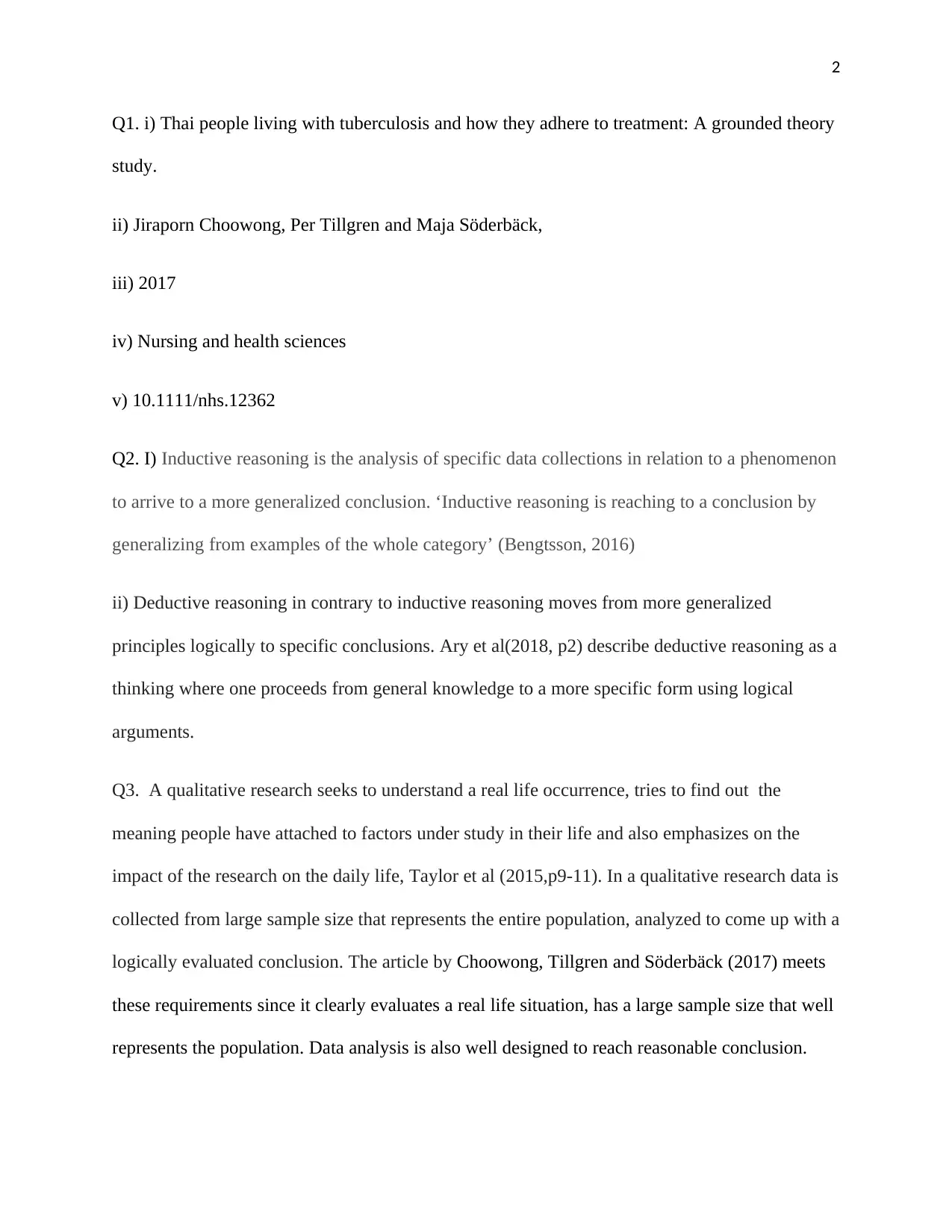
2
Q1. i) Thai people living with tuberculosis and how they adhere to treatment: A grounded theory
study.
ii) Jiraporn Choowong, Per Tillgren and Maja Söderbäck,
iii) 2017
iv) Nursing and health sciences
v) 10.1111/nhs.12362
Q2. I) Inductive reasoning is the analysis of specific data collections in relation to a phenomenon
to arrive to a more generalized conclusion. ‘Inductive reasoning is reaching to a conclusion by
generalizing from examples of the whole category’ (Bengtsson, 2016)
ii) Deductive reasoning in contrary to inductive reasoning moves from more generalized
principles logically to specific conclusions. Ary et al(2018, p2) describe deductive reasoning as a
thinking where one proceeds from general knowledge to a more specific form using logical
arguments.
Q3. A qualitative research seeks to understand a real life occurrence, tries to find out the
meaning people have attached to factors under study in their life and also emphasizes on the
impact of the research on the daily life, Taylor et al (2015,p9-11). In a qualitative research data is
collected from large sample size that represents the entire population, analyzed to come up with a
logically evaluated conclusion. The article by Choowong, Tillgren and Söderbäck (2017) meets
these requirements since it clearly evaluates a real life situation, has a large sample size that well
represents the population. Data analysis is also well designed to reach reasonable conclusion.
Q1. i) Thai people living with tuberculosis and how they adhere to treatment: A grounded theory
study.
ii) Jiraporn Choowong, Per Tillgren and Maja Söderbäck,
iii) 2017
iv) Nursing and health sciences
v) 10.1111/nhs.12362
Q2. I) Inductive reasoning is the analysis of specific data collections in relation to a phenomenon
to arrive to a more generalized conclusion. ‘Inductive reasoning is reaching to a conclusion by
generalizing from examples of the whole category’ (Bengtsson, 2016)
ii) Deductive reasoning in contrary to inductive reasoning moves from more generalized
principles logically to specific conclusions. Ary et al(2018, p2) describe deductive reasoning as a
thinking where one proceeds from general knowledge to a more specific form using logical
arguments.
Q3. A qualitative research seeks to understand a real life occurrence, tries to find out the
meaning people have attached to factors under study in their life and also emphasizes on the
impact of the research on the daily life, Taylor et al (2015,p9-11). In a qualitative research data is
collected from large sample size that represents the entire population, analyzed to come up with a
logically evaluated conclusion. The article by Choowong, Tillgren and Söderbäck (2017) meets
these requirements since it clearly evaluates a real life situation, has a large sample size that well
represents the population. Data analysis is also well designed to reach reasonable conclusion.
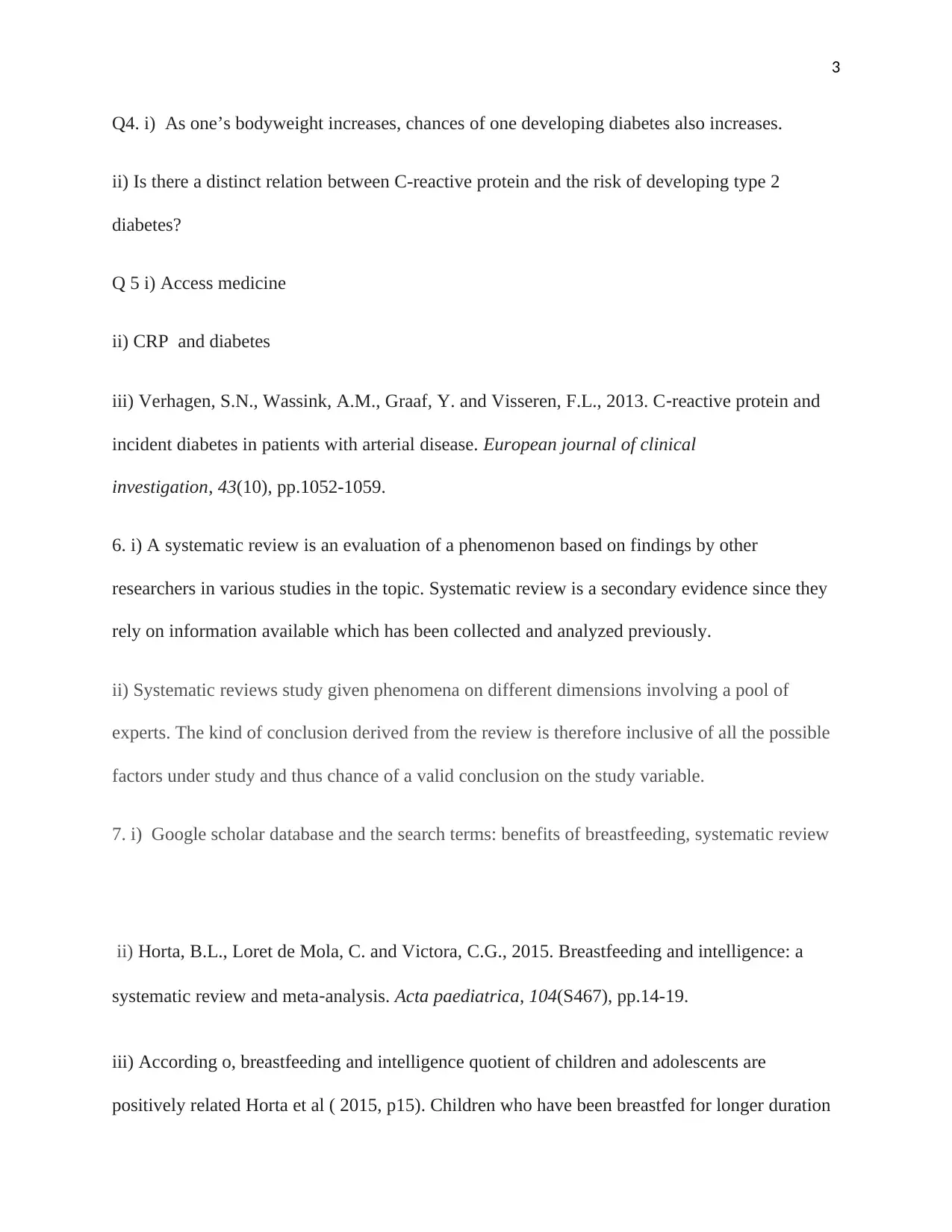
3
Q4. i) As one’s bodyweight increases, chances of one developing diabetes also increases.
ii) Is there a distinct relation between C-reactive protein and the risk of developing type 2
diabetes?
Q 5 i) Access medicine
ii) CRP and diabetes
iii) Verhagen, S.N., Wassink, A.M., Graaf, Y. and Visseren, F.L., 2013. C‐reactive protein and
incident diabetes in patients with arterial disease. European journal of clinical
investigation, 43(10), pp.1052-1059.
6. i) A systematic review is an evaluation of a phenomenon based on findings by other
researchers in various studies in the topic. Systematic review is a secondary evidence since they
rely on information available which has been collected and analyzed previously.
ii) Systematic reviews study given phenomena on different dimensions involving a pool of
experts. The kind of conclusion derived from the review is therefore inclusive of all the possible
factors under study and thus chance of a valid conclusion on the study variable.
7. i) Google scholar database and the search terms: benefits of breastfeeding, systematic review
ii) Horta, B.L., Loret de Mola, C. and Victora, C.G., 2015. Breastfeeding and intelligence: a
systematic review and meta‐analysis. Acta paediatrica, 104(S467), pp.14-19.
iii) According o, breastfeeding and intelligence quotient of children and adolescents are
positively related Horta et al ( 2015, p15). Children who have been breastfed for longer duration
Q4. i) As one’s bodyweight increases, chances of one developing diabetes also increases.
ii) Is there a distinct relation between C-reactive protein and the risk of developing type 2
diabetes?
Q 5 i) Access medicine
ii) CRP and diabetes
iii) Verhagen, S.N., Wassink, A.M., Graaf, Y. and Visseren, F.L., 2013. C‐reactive protein and
incident diabetes in patients with arterial disease. European journal of clinical
investigation, 43(10), pp.1052-1059.
6. i) A systematic review is an evaluation of a phenomenon based on findings by other
researchers in various studies in the topic. Systematic review is a secondary evidence since they
rely on information available which has been collected and analyzed previously.
ii) Systematic reviews study given phenomena on different dimensions involving a pool of
experts. The kind of conclusion derived from the review is therefore inclusive of all the possible
factors under study and thus chance of a valid conclusion on the study variable.
7. i) Google scholar database and the search terms: benefits of breastfeeding, systematic review
ii) Horta, B.L., Loret de Mola, C. and Victora, C.G., 2015. Breastfeeding and intelligence: a
systematic review and meta‐analysis. Acta paediatrica, 104(S467), pp.14-19.
iii) According o, breastfeeding and intelligence quotient of children and adolescents are
positively related Horta et al ( 2015, p15). Children who have been breastfed for longer duration
⊘ This is a preview!⊘
Do you want full access?
Subscribe today to unlock all pages.

Trusted by 1+ million students worldwide

4
show improved performance in intelligent tests. Follow-up also indicated that breastfeeding has a
positive influence on schooling and adults’ performance too.
show improved performance in intelligent tests. Follow-up also indicated that breastfeeding has a
positive influence on schooling and adults’ performance too.
Paraphrase This Document
Need a fresh take? Get an instant paraphrase of this document with our AI Paraphraser
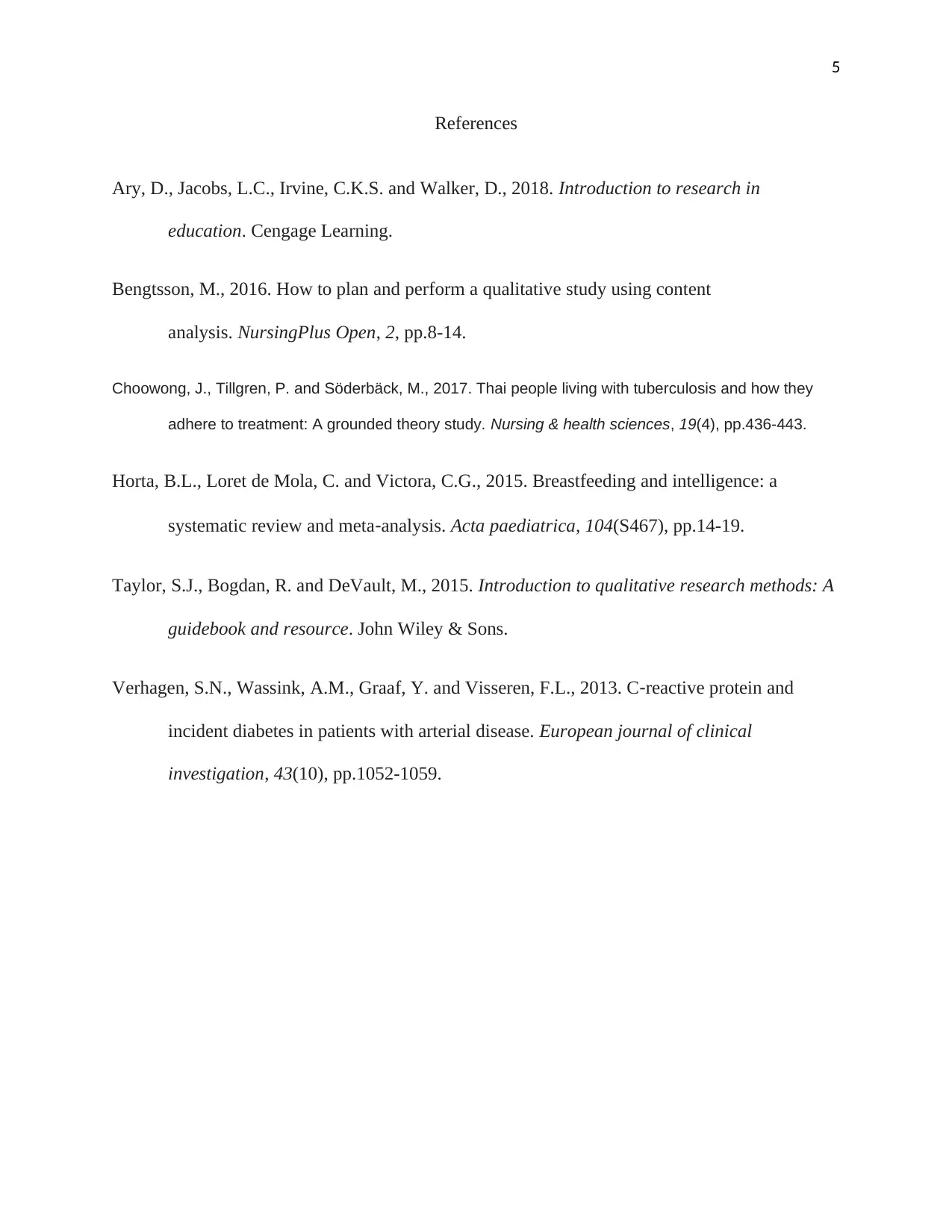
5
References
Ary, D., Jacobs, L.C., Irvine, C.K.S. and Walker, D., 2018. Introduction to research in
education. Cengage Learning.
Bengtsson, M., 2016. How to plan and perform a qualitative study using content
analysis. NursingPlus Open, 2, pp.8-14.
Choowong, J., Tillgren, P. and Söderbäck, M., 2017. Thai people living with tuberculosis and how they
adhere to treatment: A grounded theory study. Nursing & health sciences, 19(4), pp.436-443.
Horta, B.L., Loret de Mola, C. and Victora, C.G., 2015. Breastfeeding and intelligence: a
systematic review and meta‐analysis. Acta paediatrica, 104(S467), pp.14-19.
Taylor, S.J., Bogdan, R. and DeVault, M., 2015. Introduction to qualitative research methods: A
guidebook and resource. John Wiley & Sons.
Verhagen, S.N., Wassink, A.M., Graaf, Y. and Visseren, F.L., 2013. C‐reactive protein and
incident diabetes in patients with arterial disease. European journal of clinical
investigation, 43(10), pp.1052-1059.
References
Ary, D., Jacobs, L.C., Irvine, C.K.S. and Walker, D., 2018. Introduction to research in
education. Cengage Learning.
Bengtsson, M., 2016. How to plan and perform a qualitative study using content
analysis. NursingPlus Open, 2, pp.8-14.
Choowong, J., Tillgren, P. and Söderbäck, M., 2017. Thai people living with tuberculosis and how they
adhere to treatment: A grounded theory study. Nursing & health sciences, 19(4), pp.436-443.
Horta, B.L., Loret de Mola, C. and Victora, C.G., 2015. Breastfeeding and intelligence: a
systematic review and meta‐analysis. Acta paediatrica, 104(S467), pp.14-19.
Taylor, S.J., Bogdan, R. and DeVault, M., 2015. Introduction to qualitative research methods: A
guidebook and resource. John Wiley & Sons.
Verhagen, S.N., Wassink, A.M., Graaf, Y. and Visseren, F.L., 2013. C‐reactive protein and
incident diabetes in patients with arterial disease. European journal of clinical
investigation, 43(10), pp.1052-1059.
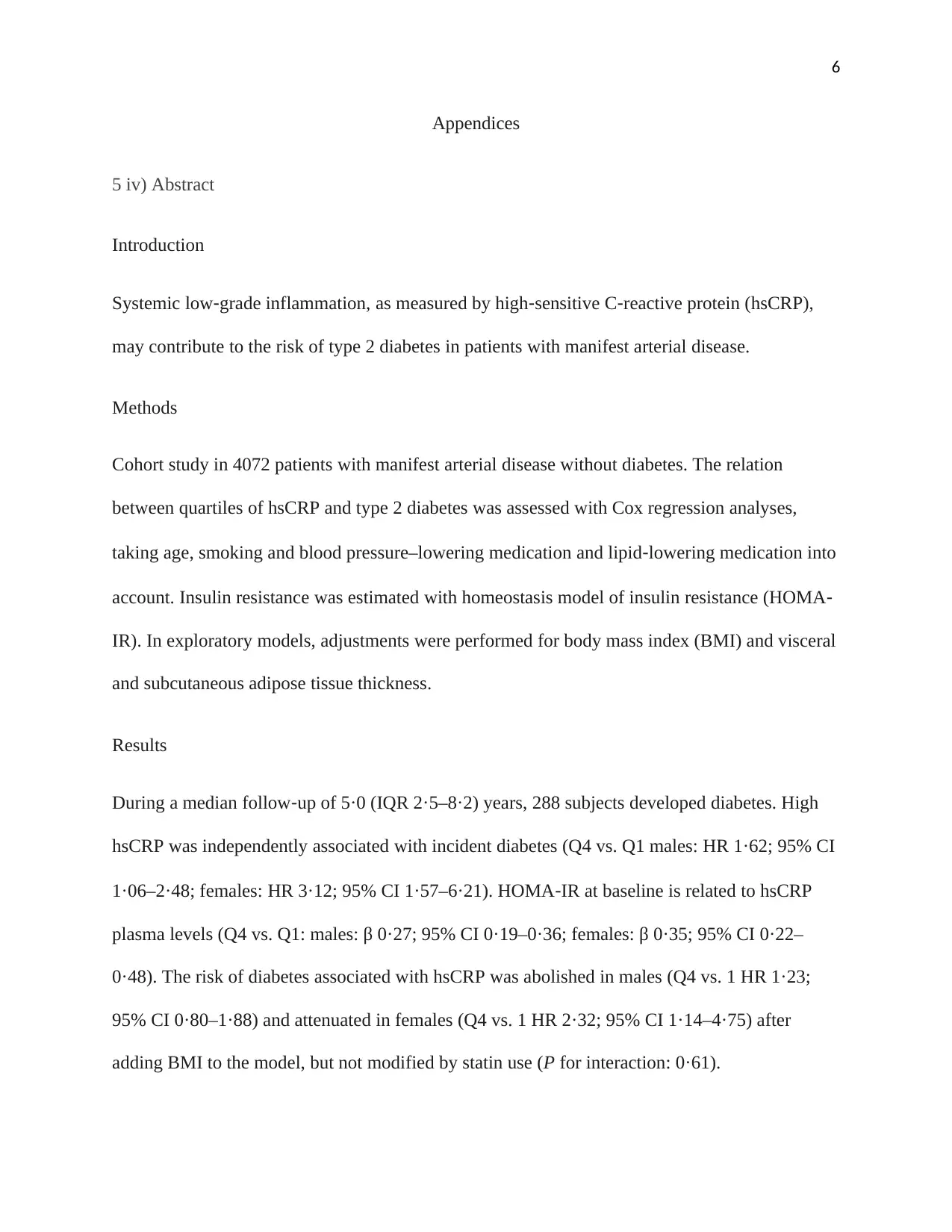
6
Appendices
5 iv) Abstract
Introduction
Systemic low‐grade inflammation, as measured by high‐sensitive C‐reactive protein (hsCRP),
may contribute to the risk of type 2 diabetes in patients with manifest arterial disease.
Methods
Cohort study in 4072 patients with manifest arterial disease without diabetes. The relation
between quartiles of hsCRP and type 2 diabetes was assessed with Cox regression analyses,
taking age, smoking and blood pressure–lowering medication and lipid‐lowering medication into
account. Insulin resistance was estimated with homeostasis model of insulin resistance (HOMA‐
IR). In exploratory models, adjustments were performed for body mass index (BMI) and visceral
and subcutaneous adipose tissue thickness.
Results
During a median follow‐up of 5·0 (IQR 2·5–8·2) years, 288 subjects developed diabetes. High
hsCRP was independently associated with incident diabetes (Q4 vs. Q1 males: HR 1·62; 95% CI
1·06–2·48; females: HR 3·12; 95% CI 1·57–6·21). HOMA‐IR at baseline is related to hsCRP
plasma levels (Q4 vs. Q1: males: β 0·27; 95% CI 0·19–0·36; females: β 0·35; 95% CI 0·22–
0·48). The risk of diabetes associated with hsCRP was abolished in males (Q4 vs. 1 HR 1·23;
95% CI 0·80–1·88) and attenuated in females (Q4 vs. 1 HR 2·32; 95% CI 1·14–4·75) after
adding BMI to the model, but not modified by statin use (P for interaction: 0·61).
Appendices
5 iv) Abstract
Introduction
Systemic low‐grade inflammation, as measured by high‐sensitive C‐reactive protein (hsCRP),
may contribute to the risk of type 2 diabetes in patients with manifest arterial disease.
Methods
Cohort study in 4072 patients with manifest arterial disease without diabetes. The relation
between quartiles of hsCRP and type 2 diabetes was assessed with Cox regression analyses,
taking age, smoking and blood pressure–lowering medication and lipid‐lowering medication into
account. Insulin resistance was estimated with homeostasis model of insulin resistance (HOMA‐
IR). In exploratory models, adjustments were performed for body mass index (BMI) and visceral
and subcutaneous adipose tissue thickness.
Results
During a median follow‐up of 5·0 (IQR 2·5–8·2) years, 288 subjects developed diabetes. High
hsCRP was independently associated with incident diabetes (Q4 vs. Q1 males: HR 1·62; 95% CI
1·06–2·48; females: HR 3·12; 95% CI 1·57–6·21). HOMA‐IR at baseline is related to hsCRP
plasma levels (Q4 vs. Q1: males: β 0·27; 95% CI 0·19–0·36; females: β 0·35; 95% CI 0·22–
0·48). The risk of diabetes associated with hsCRP was abolished in males (Q4 vs. 1 HR 1·23;
95% CI 0·80–1·88) and attenuated in females (Q4 vs. 1 HR 2·32; 95% CI 1·14–4·75) after
adding BMI to the model, but not modified by statin use (P for interaction: 0·61).
⊘ This is a preview!⊘
Do you want full access?
Subscribe today to unlock all pages.

Trusted by 1+ million students worldwide
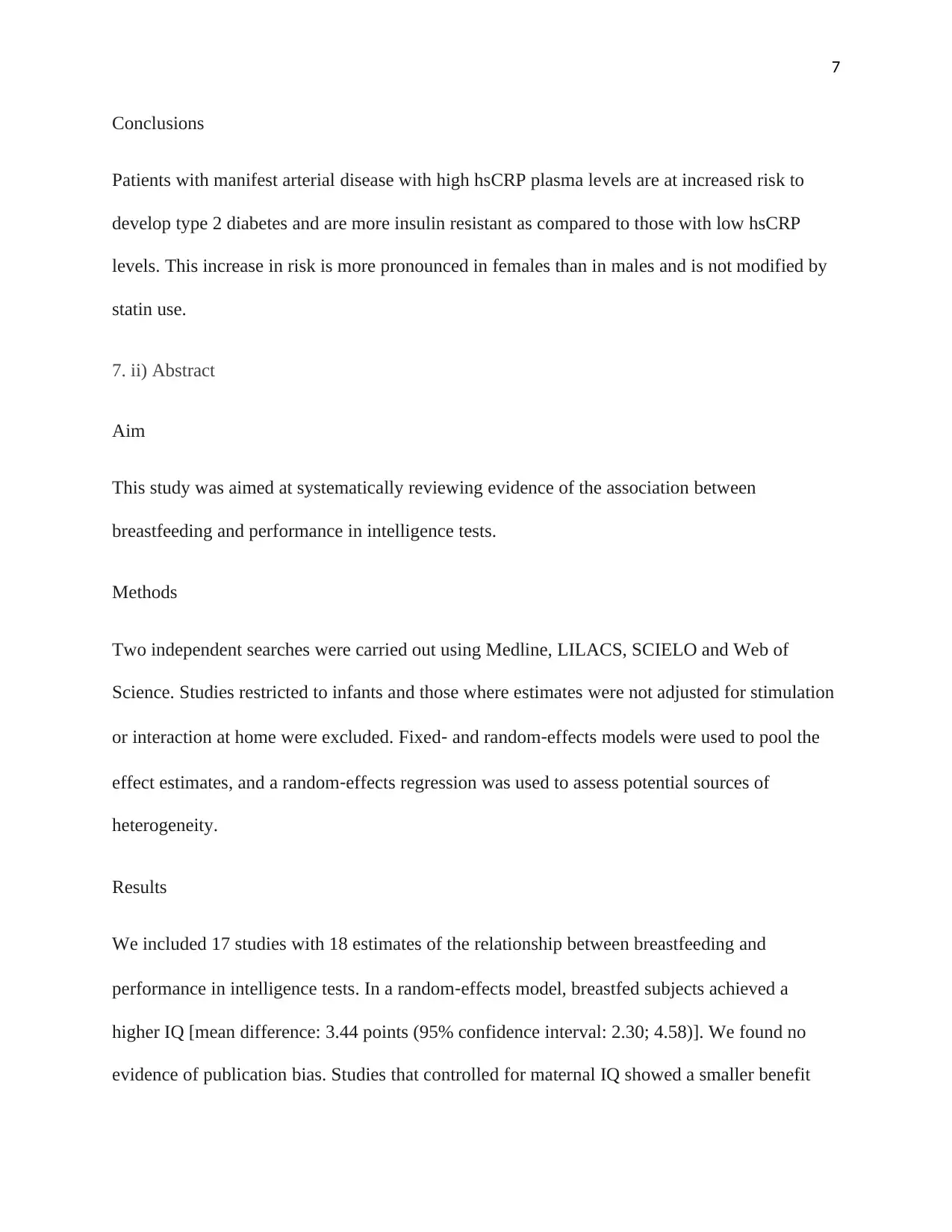
7
Conclusions
Patients with manifest arterial disease with high hsCRP plasma levels are at increased risk to
develop type 2 diabetes and are more insulin resistant as compared to those with low hsCRP
levels. This increase in risk is more pronounced in females than in males and is not modified by
statin use.
7. ii) Abstract
Aim
This study was aimed at systematically reviewing evidence of the association between
breastfeeding and performance in intelligence tests.
Methods
Two independent searches were carried out using Medline, LILACS, SCIELO and Web of
Science. Studies restricted to infants and those where estimates were not adjusted for stimulation
or interaction at home were excluded. Fixed‐ and random‐effects models were used to pool the
effect estimates, and a random‐effects regression was used to assess potential sources of
heterogeneity.
Results
We included 17 studies with 18 estimates of the relationship between breastfeeding and
performance in intelligence tests. In a random‐effects model, breastfed subjects achieved a
higher IQ [mean difference: 3.44 points (95% confidence interval: 2.30; 4.58)]. We found no
evidence of publication bias. Studies that controlled for maternal IQ showed a smaller benefit
Conclusions
Patients with manifest arterial disease with high hsCRP plasma levels are at increased risk to
develop type 2 diabetes and are more insulin resistant as compared to those with low hsCRP
levels. This increase in risk is more pronounced in females than in males and is not modified by
statin use.
7. ii) Abstract
Aim
This study was aimed at systematically reviewing evidence of the association between
breastfeeding and performance in intelligence tests.
Methods
Two independent searches were carried out using Medline, LILACS, SCIELO and Web of
Science. Studies restricted to infants and those where estimates were not adjusted for stimulation
or interaction at home were excluded. Fixed‐ and random‐effects models were used to pool the
effect estimates, and a random‐effects regression was used to assess potential sources of
heterogeneity.
Results
We included 17 studies with 18 estimates of the relationship between breastfeeding and
performance in intelligence tests. In a random‐effects model, breastfed subjects achieved a
higher IQ [mean difference: 3.44 points (95% confidence interval: 2.30; 4.58)]. We found no
evidence of publication bias. Studies that controlled for maternal IQ showed a smaller benefit
Paraphrase This Document
Need a fresh take? Get an instant paraphrase of this document with our AI Paraphraser
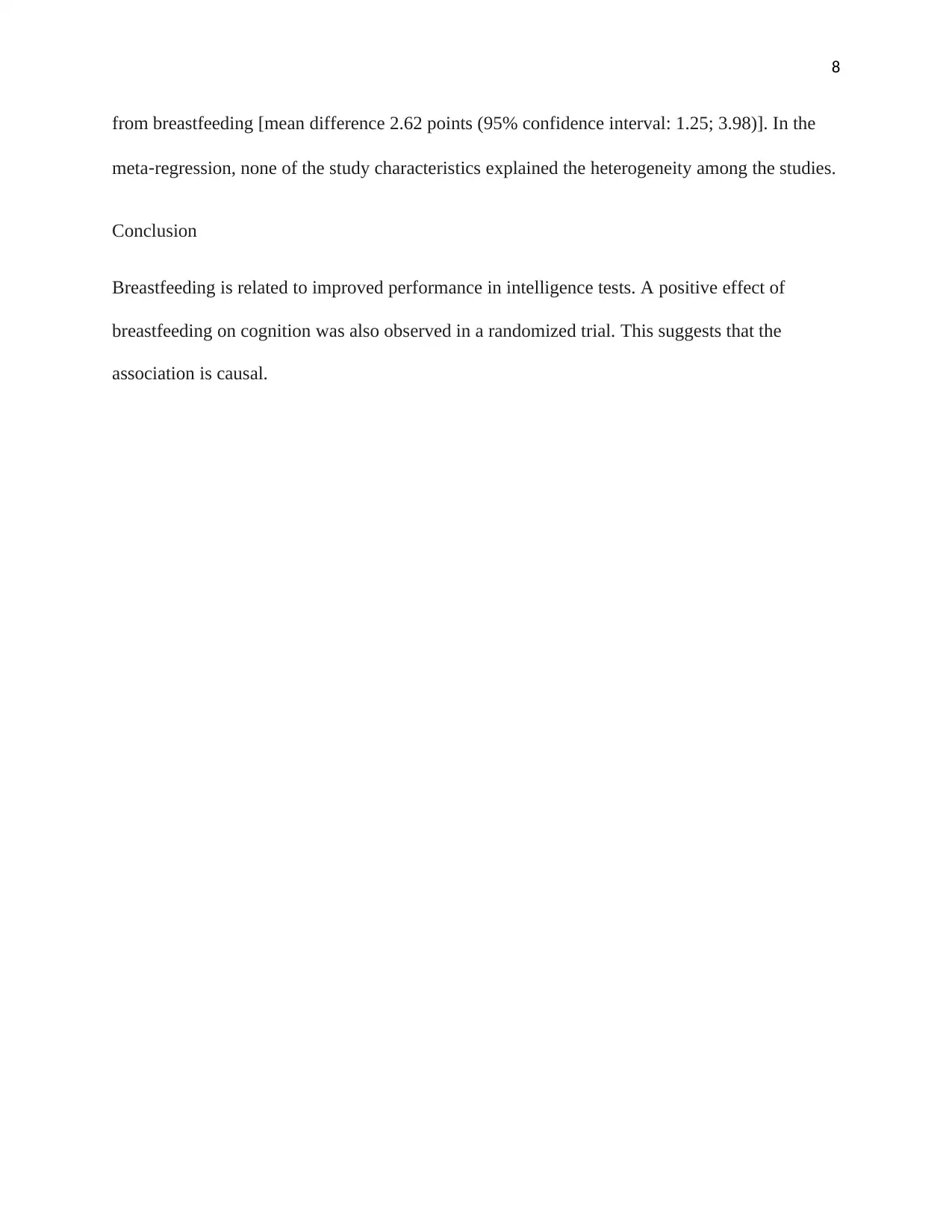
8
from breastfeeding [mean difference 2.62 points (95% confidence interval: 1.25; 3.98)]. In the
meta‐regression, none of the study characteristics explained the heterogeneity among the studies.
Conclusion
Breastfeeding is related to improved performance in intelligence tests. A positive effect of
breastfeeding on cognition was also observed in a randomized trial. This suggests that the
association is causal.
from breastfeeding [mean difference 2.62 points (95% confidence interval: 1.25; 3.98)]. In the
meta‐regression, none of the study characteristics explained the heterogeneity among the studies.
Conclusion
Breastfeeding is related to improved performance in intelligence tests. A positive effect of
breastfeeding on cognition was also observed in a randomized trial. This suggests that the
association is causal.
1 out of 8
Your All-in-One AI-Powered Toolkit for Academic Success.
+13062052269
info@desklib.com
Available 24*7 on WhatsApp / Email
![[object Object]](/_next/static/media/star-bottom.7253800d.svg)
Unlock your academic potential
Copyright © 2020–2025 A2Z Services. All Rights Reserved. Developed and managed by ZUCOL.

